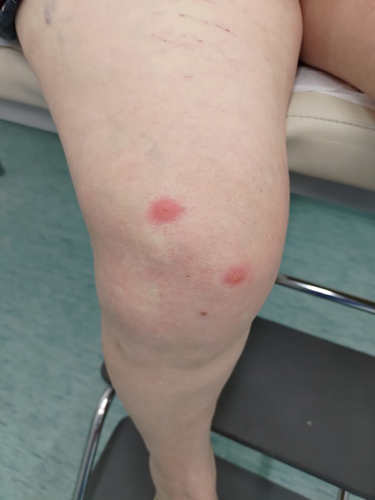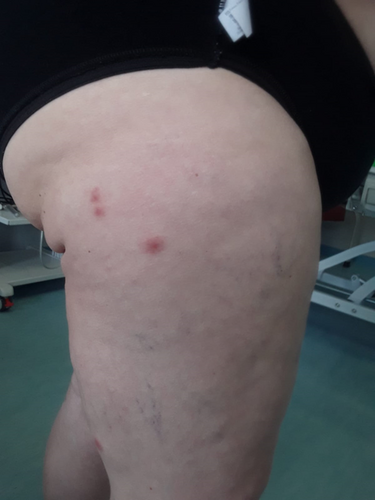Monkeypox in a 71-year-old woman
We read with interest the article of Saxena et al.1 Since May 7, 2022, unprecedented outbreaks of monkeypox (MPX) cases have largely spread outside endemic regions thus alerting the scientific community and beyond.2
As of 29 June, 4178 cases of MPX have been reported from 31 countries and areas throughout the European region.3 So far, most current European MPX outbreaks have involved young men who have sex with men (MSM) who visited festivals, aggregation events, and recreational activities.4, 5 Conversely, data regarding MPX cases are lacking in the elderly, particularly women.
We describe a case of MPX that occurred in a 71-year-old Italian woman with no recent travel history, she referred to having engaged in sexual activity with multiple partners in the last year; her main comorbidities were diabetes, obesity, hypertension, and bipolar disorder. On June 19, the patient, who underwent smallpox vaccine, accessed the emergency room reporting fever, fatigue, drowsiness, and an extensive maculopapular rash that had appeared 7 days after sexual intercourse with a 56-year-old man who, similarly, had presented skin lesions on the trunk and arms and had not recently traveled.
On admission to our Infectious Diseases ward, multiple papular lesions were observed on her trunk and buttocks; other lesions with central umbilication were on her knees (Figure 1) and the right proximal of the leg (Figure 2). Inguinal lymphadenopathy was also evidenced. Samples from lesions swabs resulted positive for MPX viral DNA by real-time polymerase chain reaction, whereas viremia was negative.


She tested negative for HIV, HBV, HCV, and syphilis. Laboratory parameters were normal. Antiviral treatment was not required.
Samples from the patient's sexual partner were collected from blood, throat, and skin lesions that appeared as partially removed crusted lesions on the trunk. From all sampling sites, viral DNA was not detected suggesting that MPX skin lesions may have regressed.
After 3 days of hospitalization, the woman was discharged in good clinical condition and continued isolation at home.
To our knowledge, this is the first European case of not-imported MPX in an older woman. Recent studies reported MPX cases in MSM who traveled to other European countries.4, 5 Differently, our patient, the patient had no travel history even though she engaged in sexual activity with multiple partners as a major risk factor thus reinforcing the evidence that sexual transmission may play a predominant role in the current outbreaks regardless of gender and age.
We hypothesize that the spread of MPX outbreaks may be underestimated due to the variability of the clinical manifestations. In fact, skin lesions cannot be easily identified since they can be mistaken in certain cases for other skin diseases such as chickenpox, shingles, measles, bacterial skin infections, scabies, syphilis, and drug-associated allergies.
Following the discontinuation of smallpox vaccination over 40 years ago, it is estimated that over 70% of the world's population is no longer protected against smallpox, and through cross-immunity, to MPX.6, 7
In this evolving scenario, it is not clear yet if the clinical burden of MPX might become relevant among people who had already undergone a smallpox vaccine. We assume that some individuals, despite a previous smallpox vaccine, may develop a milder disease with a favorable outcome, as reported in our case. However, cross-immunity may be reduced, especially in elderly and immunosuppressed individuals.8 Thus, further studies are required to assess the hypothesis of a vaccine booster in high-risk categories.
Despite the increasing number of cases reported in the ongoing outbreaks, hospitalization was needed in about 10% of cases,2 suggesting a benign clinical course. On the other hand, it should be taken into account that MPX may be associated with fearful complications including pneumonia, dehydration, sepsis, and other life-threatening conditions.9
Finally, several needs have emerged. First, efforts should be strengthened to understand the routes of transmission, viral reservoirs, and the global spread of the different clades.
Second, earlier identification of cases combined with public health measures including surveillance, and contact tracing, is demanded. Third, randomized trials evaluating antivirals and vaccine efficacy and safety should be strongly encouraged.
Fourth, educational approaches should be promoted to increase risk perception and prevent MPX stigma. Hence, the Joint United Nations Program on HIV/AIDS (UNAIDS) recently expressed concern that some comments in the media regarding current MPX outbreaks were reinforcing homophobic and racist stereotypes.10 Therefore, it is necessary to develop a complete understanding of this infection to educate the community with awareness without creating unfounded panic and prejudice.
AUTHOR CONTRIBUTIONS
All authors contributed to writing and editing the manuscript.
CONFLICT OF INTEREST
The authors declare no conflict of interest.
Open Research
DATA AVAILABILITY STATEMENT
The data that support the findings of this study are available from the corresponding author upon reasonable request.




